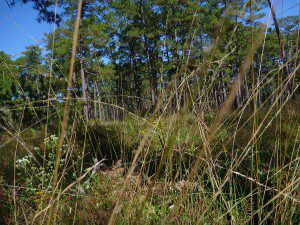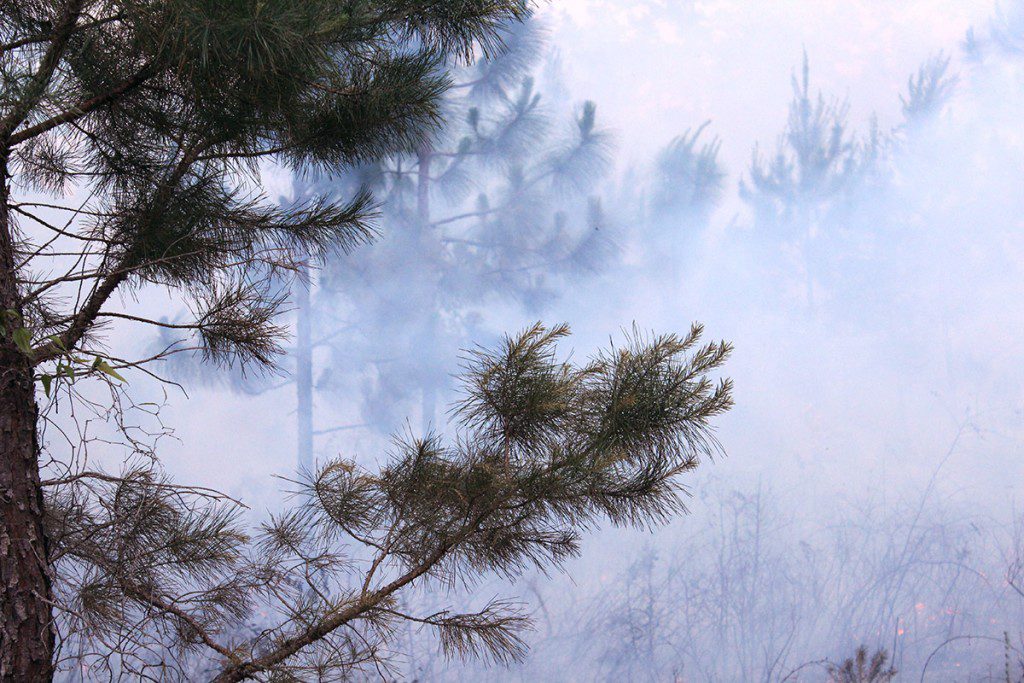Welcome to Part 2 (of 10) of Roaming the Red Hills, which originally aired on the March 31 episode of WFSU’s Local Routes. Over ten 3-minute videos, we’ll explore the natural soul of the Red Hills of Florida and Georgia, from the pine uplands down to its rivers, lakes, and farms. Thanks to Tracy Horenbein for creating original compositions for this video series. The series is narrated by Jim McMurtry.
Funding for Roaming the Red Hills was provided by Tall Timbers Research Station and Land Conservancy.
Rob Diaz de Villegas WFSU-TV
In hands that look like they’d climbed more than thirty feet up a pine tree, Jim Cox holds a seven day old red cockaded woodpecker. There’s a stark contrast between the roughness of Jim’s hands and the delicacy of this new life, gently removed from its cavity high above in a mature longleaf pine. It’s not unlike the delicate state of its species, making a comeback, but only with a lot of human help, and making its home in the roughness of an ecosystem built for regular burning. Beneath RCW cavities are a slick coating of sap, defense against climbing snakes. Neither snakes nor fire are the worst of the birds’ problems, however. What they really need is older trees.
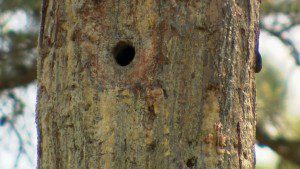
Red cockaded woodpecker cavity located at Tall Timbers Research Station & Land Conservancy. RCWs build cavities over multiple generations. This may be part of why the birds are cooperative breeders, with extended family helping parents raise young. Note the sap running down the tree. Red cockaded woodpeckers score the tree to release it as a defense against predators.
“The problem with 90 year old trees is that it takes 90 years to grow them.” Jim told our EcoShakespeare adventurers on a visit to an old growth forest back in 2014. Jim is the Vertebrate Ecology Program Director at Tall Timbers Research Station and Land Conservancy, and he’s an expert when it comes to the birds of the longleaf pine ecosystem. On the EcoShakespeare trip, he netted a Henslow’s sparrow, a migratory bird that winters in our southern pinelands. Earlier that year, he netted a Bachman’s sparrow for the SciGirls. As Jim tells us in the video above, the Bachman’s is one of three species endemic to the longleaf habitat. The difference between the red cockaded woodpecker and those sparrows is that while the sparrows live in the understory between the pines, RCWs need the trees themselves. As you can see in the video above, a high percentage of current longleaf pine is second growth- grown after the original forest had been harvested. Much of that harvesting happened within the last century. If the red cockaded woodpecker is going to move of off the endangered species list, it’s going to have to wait for more trees to grow up.
At about 90 years or so, longleaf is more likely to contract red heart disease, a fungus which will soften its wood. Where most woodpeckers prefer to nest in dead trees, the red cockaded prefers them living. With a shortage of trees that meet its needs, scientists and land managers have turned to artificial cavities installed in younger pine. This practice has helped increase the population of the species, which keeps from being listed as endangered on some lists. It has been listed by the US Fish and Wildlife Service since 1970. While its numbers are rebounding, it will continue to be reliant on people until there are more suitable trees in which it can build its own cavities.
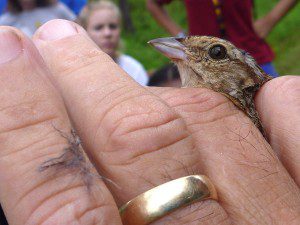
The Bachman’s sparrow is one of three bird species endemic to the longleaf pinewoods of the southeast, along with the red cockaded woodpecker and brown headed nuthatch. All three species are threatened by a decline in longleaf habitat.
The Red Hills region is home to 3-4% of the total population, based on a 2008 survey conducted by Jim, Dr. Todd Engstrom, and Wilson Baker for Tall Timbers. It is the largest population on private land, about 179 RCW clusters living in a contiguous longleaf forest, maintained with fire, for the purpose of quail hunting. Red Hills pinelands are mostly on private property, so while landowners have been generous enough to allow access to our cameras so that you may see them, you can’t go bird watching there. Luckily, our area has the best public lands for RCW viewing.
To the south and west of Tallahassee, about 1,200 red cockaded woodpeckers in 650 groups live in the Apalachicola National Forest, the largest population on public land. The Cornell Lab of Ornithology eBird site tracks species hotspots, and if you browse their map, you can get a good idea where you might find them. You can also contribute to the map. Zooming into the Apalachicola National Forest, you can see that there are many locations where RCWs have been seen. If you love longleaf pine forests and the species that depend on them, there is no better place to live than in north Florida and south Georgia.
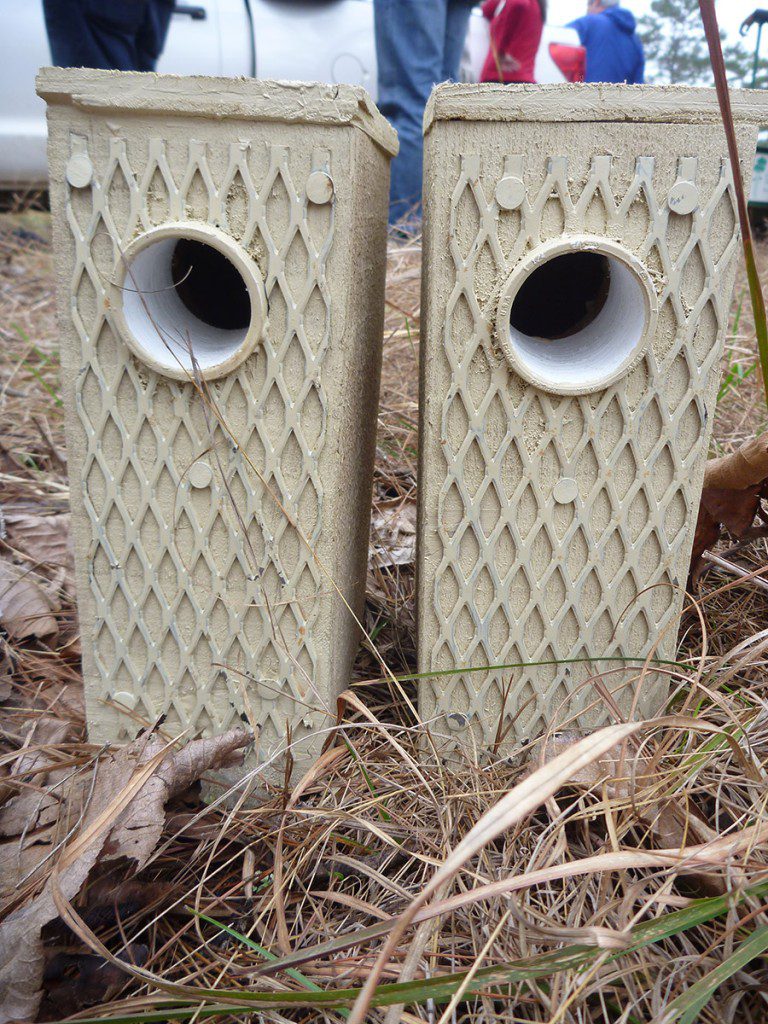
Artificial red cockaded woodpecker cavities. Where longleaf forests lack mature trees, these boxes can provide more nesting places for the birds, and facilitate more breeding.
Plants Built for Burning
The plants of the longleaf ecosystem are, as in most ecosystems, food and shelter for the animals that live there. They die and decompose into soil, sustaining other plants. As Jim Cox leads an FSU biology class through an old growth forest, he starts talking about the plants here in a different way. He’s talking about them as fuel.
“Anyone know when we burned this site? Want to take a guess?” Jim asks, plucking a few strands of wiregrass from the ground. “It was about six months. It burned in early May.” From the instant the grass burned back, a clock started. Six months have passed and the wiregrass has grown tall, green and lush. In another six to eight months, it will start sending nutrients underground. It will start looking wilted and dead. You see some grass that looks like that in the video. “It dries up and basically sets up great conditions for another fire to come through.”
Longleaf pine needles are an important fuel as well. “Longleaf pine needles are the most flammable of all pine needles” Jim tells the class. “They have a lot of good calories that are ready to light up.”
The longleaf ecosystem is one of the most diverse in North America. Over 500 different species of plants and animals call this forest home. A square meter of ground may contain 25 different species. A ten by ten square may contain up to 100. Grasses, flowers, and forbs (succulent plants) thrive in the wide spaces between pine trees, and under the the light that filters through their needles. Those same needles will fuel fire that burns those plants down to their roots. The plants don’t die, at least not the ones adapted to this ecosystem. It’s the hardwood trees, like an oak that would grow and encroach on the diverse and life sustaining ground cover plants, are burned out before they can grow.
One endangered species that relies on that open ground cover is the gopher tortoise. On our next adventure, we travel to Birdsong Nature Center to take a peak into some tortoise burrows.
Come adventure with us in the Red Hills, Apalachicola River and Bay, the Forgotten Coast, and More! Subscribe to the WFSU Ecology Blog by Email.

